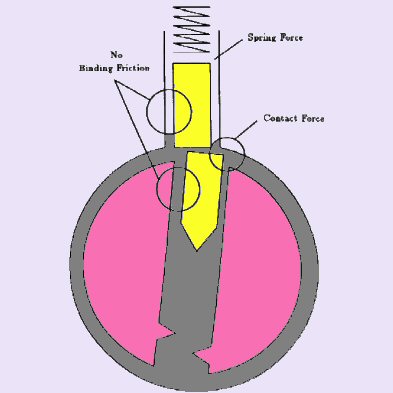You Can't Pick Locks Without Knowing About Binding Pins.
Hello!
You want to learn how to Single Pin Pick (SPP)? That's lock picking proper. After all the techniques and tricks, SPP will still open the MOST locks. Here's what you need to know:
As simple as possible: The Binding Pin Principle.
Pretty much all lock picking relies on The Binding Pin Principle. There are some exceptions, but they prove the rule. When it comes to single pin picking, even raking and pick guns, The Binding Pin Principle is at work - even if you do not see it.

This is what it feels like when you identify and pick your first binding pin.
So many times I’ve seen people unnecessarily confused by descriptions of The Binding Pin Principle, so I am going to make it clear, simple, back to basics, for in truth, it’s that important, without it, lock picking as we know it would not exist. That pins bind and in a certain order, is what allows us to pick them. Yeah, you need to know it.
Right, like I said, simple - back to basics:
A standard pin cylinder is comprised of...
The Plug: The part you insert the key, that turns to open the lock.
The pin pairs and springs: the springs push the pins into the area between the plug and the housing to prevent it turning.
The housing: The ‘body’ of the lock which contains the plug, the springs, and the pins.
The Key: which moves the pins in such a way as to match up the split between the pairs of pins along the line between the plug and the housing, (the shear line) therefore allowing it to turn.
OK. Familiarize yourself with that. Got it? Good.
So to pick a lock means manually manipulating the pins to mimic the action of the key (move the split in between the pin pair to the shear line, allowing the plug to turn and the lock to open). However, since we’re doing this one pin at a time (hence ‘single pin picking') we need to attack them in a certain order, and if we get the order wrong, it will not work.

Fig c shows the lock in its normal state. Once a tension tool has been inserted and the plug turned clockwise, it's prevented from turning any further (see fig d) due to a pin - the binding pin - which requires picking.
This is fundamental to understanding the Binding Pin principle - unless the pins are picked in a specific order, the lock will not open. And the way to find out what order is to identify and pick The Binding pin, once you've done that, another pin binds, that's the new Binding Pin, and so on - until the lock opens and you're very happy indeed!
How do we know what order to pick them? I mean there’s going to be at least five, frequently six, sometimes seven, etc. So how do we know? Because of The Binding Pin Principle! When we insert a tension tool into the lock and apply a small amount of turning pressure, the plug turns, usually about 1-2mm.
And what stops it moving? What stops the plug turning all the way round? The pins! That’s what they’re there for. But locks are not made by NASA, they are not as precise as they could be, they are in fact quite imprecise. This means, when the plug is turned by the The tension tool, only one pin actually stops the plug turning.
Can you picture a perfectly made lock where each pin would engage at the exact same time? Yeah, that doesn’t happen, just one pin is trapped between the plug and housing.
I said trapped, I could have described it as ‘Binding’, boom! We are at the Binding Pin principle. Isn't it strange to think your entire house is locked by one little, binding, pin?
You see, the way locks are manufactured means they have a few faults. They are not made perfectly. The holes drilled along the plug (which house the pins) are not evenly placed along the plug (see fig b), and that's why one pin binds when you apply turning pressure.
If the lock was made with spaceship kind of precision, with all the holes perfectly in line (see fig a), you wouldn't have a binding pin, they would all bind simultaneously and you wouldn't be able to pick it. So it's these faults that give us a binding pin, and then the ability to pick the lock.

Now, once we’ve applied a small amount of turning pressure to the wrench, the plug has turned, and a single pin is trapped. This is the pin you need to pick FIRST. The trapped pin, the Binding Pin.
Using a pick, you can gently attempt to lift each pin one by one. Most people start at the back and work forward, or from the front and work backwards. And you’re looking for the pin offering the MOST resistance - because it’s trapped!
Once this has been picked, that is pushed up, until the top Pin is in the housing, and the bottom pin falls into the plug, what do you think happens? Correct! The plug turns a fraction of a mm and the next pin is trapped, the next pin is Binding! So you have to push each pin again to find what one is the next Binding Pin.
You keep doing that until there’s only one pin left, pick that one and the plug will turn all the way, unlocking the lock!
You will feel when the Binding Pin is picked as the plug jolts slightly, sending a message up the wrench and pick, this is often called feedback, and learning to interpret that feedback will teach you how you know you’ve picked the right pin and it’s time to move onto the next.
That is the Binding Pin principle.
Sorted!
Chris Dangerfield

